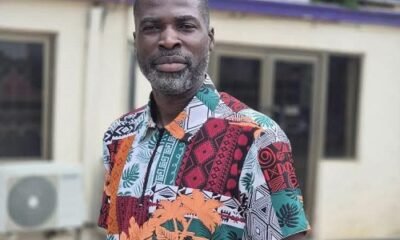Features
MEDICINES AND RISK OF LOWERING THE SEIZURE THRESHOLD
I am on medications for seizures. Recently I was diagnosed with a urinary tract infection and put on Ciprofloxacin. It was changed when my details showed a history of seizures. Kindly shed more light on this issue. Yes, it is true that Ciprofloxacin can lower the seizure threshold and therefore could precipitate a seizure for someone with a history of seizures and taking medications.
A seizure is the clinical manifestation of abnormal, excessive or synchronous neuronal firing in the brain. The clinical features of seizures may include abnormalities of consciousness, movement, sensation, behaviour and autonomic function. Epilepsy is the enduring tendency to experience seizures. The seizure threshold describes the minimum intensity of a stimulus required to induce a seizure. It is clinically evident in the context of electroconvulsive therapy, but is otherwise primarily an experimental phenomenon, in which seizures are induced by electrical or chemical stimuli.
Seizures occur when there is an excess of excitatory activity relative to inhibitory activity. Glutamate and gamma-aminobutyric acid (GABA) are, respectively, the principle excitatory and inhibitory neurotransmitters in the central nervous system (CNS). Glutamate acts via N-methyl-D-aspartate (NMDA), alpha-amino-3-hydroxy-5-methyl-4-isoxazoleproprionic acid (AMPA) and kainite receptors to cause an influx of sodium and calcium ions, favouring depolarization. GABA acts primarily through GABAA receptors to cause an influx of chloride ions, inducing hyperpolarization. The mechanisms of action of antiepileptic drugs include interference with sodium (e.g. phenytoin, carbamazepine, lamotrigine) and calcium channels (e.g. ethosuximide); enhancing the effects of GABA(e.g. benzodiazepines); antagonizing glutamate at AMPA receptors; and a combination of these effects (e.g. valproate). Drugs with the opposite effects may induce seizures.
Seizure potential is often evaluated during drug development to quantify the extent to which a drug prevents seizures (if this is the intended therapeutic effect) or induces them (as an unwanted effect). As a broader concept, it is useful in clinical practice as a framework to help understand the complex interplay between the patient, their medicines, and their risk of seizures (Hitchings .W. Drugs that lower seizure threshold. St George’s, University of London and St George’s University Hospitals NHS Foundation Trust. Thundiyil JG, Kearney TE, Olson KR. Evolving epidemiology of drug-induced seizures reported to a Poison Control Center System. Journal of Medical Toxicology 2007;3:15-9).
The propensity of a drug to induce seizures depends on its effects on neurotransmission and their timecourse (e.g. whether it increases seizure risk during use or on withdrawal), the concentration of drug reaching the brain, and the susceptibility of the individual patient. Susceptibility factors include previous seizures, structural or functional brain abnormalities, and concurrent drug use. In the face of such complexity, it is rare that seizures can be ascribed primarily to the effects of a drug (i.e. ‘drug-induced seizures’). Commonly, however, drugs contribute to a shift in excitatory/inhibitory balance which, in that individual at that time, leads to a seizure. In this respect, it is generally more helpful to regard such drugs as having lowered the seizure threshold, rather than having incited seizures.
Many drugs have indirect effects on the seizure threshold, for example by inducing hypoglycaemia, electrolyte disturbances or respiratory depression, or by interacting with antiepileptic therapy. Drugs with potential to lower the seizure threshold are numerous and diverse. Whether they contribute to clinically overt seizures depends on the dosage in which they are taken, the time-course of their effects, and the susceptibility of the patient. It is important to add that the contribution of medicines to seizure risk is potentially modifiable. For antimicrobials, the beta-lactams (penicillins, cephalosporins and carbapenems), interact with the GABAA receptor to interfere with the inhibitory effects of GABA in a concentration-dependent manner. Correspondingly, they have dose-dependent effects on the seizure threshold. However, the CNS penetration of penicillins and cephalosporins is relatively low. As such, most reports of seizures associated with these agents emerge from their use in high doses (often in the treatment of CNS infections) or in renal failure. Carbapenems more readily penetrate the CNS and their use is associated with an increased seizure risk compared with non-carbapenem antibiotics. Among the carbapenems, imipenem is generally regarded to have the highest risk. However, this may be because studies conducted on the newer agents (meropenem, ertapenem and doripenem), informed by earlier experience with imipenem, generally excluded patients with a history of seizures. All cephalosporins have the propensity to lower the seizure threshold but the one often associated with this phenomenon is cefipime. The quinolones are another group with the most common ones being ciprofloxacin and levofloxacin.
The antituberculous agent isoniazid inhibits pyridoxine phosphokinase, the enzyme which converts pyridoxine to its active form, pyridoxal-5-phosphate. Pyridoxal-5-phosphate is an essential cofactor in the synthesis of GABA from glutamate. The resulting fall in inhibitory activity and rise in excitatory activity leads to a dose-dependent reduction in the seizure threshold. Isoniazid toxicity is characterised by a triad of altered mental status, metabolic acidosis and refractory seizures. Treatment with pyridoxine and a benzodiazepine usually results in prompt seizure termination.
The antimalarial agents mefloquine and chloroquine can precipitate seizures in people with epilepsy. This effect has been reported even in healthy individuals.Antipsychotics are another group with the most common ones being chlorpromazine and clozapine. Some antidepressants also have this tendency with the notable ones being Amitriptylline and Venlafaxine..Seizures are common in cases of antidepressant overdose, particularly with venlafaxine and TCAs.
Narcotics such as Meperidine, Fentanyl and tramadol have also been associated with lowering of the seizure threshold.Many drugs can adversely affect the seizure threshold, although whether this leads to overt seizures depends on the concentration of drug reaching the brain, the susceptibility of the individual to its effects, and how these effects vary over time. In managing patients with epilepsy or other risk factors for seizures, one must be mindful of the potential for medications to lower the seizure threshold, so as not to precipitate avoidable seizures. Likewise, in evaluating patients with seizures, consideration must be given to the seizure-provoking potential of their medications. As noted by Hitchings information on the intended medicine’s risk to lowering the seizure threshold becomes an important factor in the decision to withhold or stop the medication to improve seizure control or prevent it in the first place.
As always use medicines safely. Always consult your pharmacist on safe use of medicines.
DR. EDWARD O. AMPORFUL
CHIEF PHARMACIST
COCOA CLINIC
Features
Ghana becoming a developed nation
In a country like ours in which we are aware of our challenges, all that is required is focusing on strengthening our institutional processes by making them more robust and transparent. In this regard, investment in digitilisation must be prioritised since the human element to cut corners is inherent in the psyche of some people and therefore cannot be trusted to do the right things out of their own volition.
Enforcement of existing laws and regulations must be reviewed to see what is working, which ones have to be tweaked to be able to address current challenges, and those that have become obsolete and must be discarded.
One issue that needs to be given priority attention is remuneration. A former President is alleged to declare that we pretend to pay workers and they also pretend to work. This indeed sums up the quandary facing government after government. Workers’ salaries are crucial in the fight against corruption. A realistic living wage must be given to workers; otherwise, they will seek avenues to address their personal budget deficit.
On day one, what should engage the attention of government is Energy, making it available and affordable. The industrialisation agenda cannot be successfully executed without power that is readily available, reliable, and affordable. Solar energy must be factored in the quest for affordable and reliable power for industry.
The fuel sector issues must be urgently addressed so that it can impact positively on the transportation sector, which plays a key role in the supply of goods and services. The railway infrastructure plan linking places like Boankra Inland Port to prolong the lifespan of our roads and to fast track distribution of goods from the Capital City to the inland areas of the country should be a top priority item.
A well-structured system linking industry to academia must be quickly established to serve as a catalyst towards the industrialisation drive. Research findings from the universities must be channelled to captains of industry in a timely manner. Effective channels of communication should be established to facilitate shorter product-to-market times.
An effective mechanism for fishing out needy but talented children must be established, as well as a sponsorship package for talented individuals who are needed for certain critical areas of the economy — what I term critical investment in education.
Certain changes must be made in the constitution, particularly the appointment of the heads of certain constitutional bodies or institutions. This is to ensure that the Executive arm of government does not wield too much power to ensure accountability and checks and balances really work.
The Attorney General’s Office must be detached from the Executive arm of government. The Nolle Prosequi provision must also be amended to compel the Attorney General to give an explanation of why he or she is declining to prosecute a particular case or discontinue it. The provision that protects sitting Presidents from prosecution must also be reviewed.
The punishment for some of our laws needs a review. We must review the removal of CJ provision to ensure the independence of the Judiciary.
Above all, there must be a mindset of change, i.e., a paradigm shift from inability to capability. Inferiority complex must give way to a pacesetters mentality, and all will be well. God bless.
NB: KOTOKA INTERNATIONAL AIRPORT TO KOFI BAAKO INTERNATIONAL AIRPORT
BY LAUD KISSI-MENSAH
Join our WhatsApp Channel now!
https://whatsapp.com/channel/0029VbBElzjInlqHhl1aTU27
Features
The impact of emotional surgery and emotional elysium on neurological and neurosurgical procedures
Abstract
THIS comprehensive review aims to explore the impact of emotional surgery and emotional elysium on neurological and neurosurgical procedures. We examine the scientific literature on these approaches, including their definitions, theoretical frameworks, and applications. Our analysis highlights the potential benefits and risks of these approaches and discusses their implications for practice.
Introduction
Neurological and neurosurgical procedures are complex and delicate, requiring precision and accuracy to achieve optimal outcomes. Emotional surgery and emotional elysium are two innovative approaches that have the potential to enhance the success of these procedures. Emotional surgery involves the use of art and other creative techniques to promote relaxation and reduce stress, while emotional elysium focuses on cultivating positive emotions and promoting emotional well-being.
The Role of Emotional Surgery in Neurological and Neurosurgical Procedures
Emotional surgery has been shown to be effective in reducing anxiety and stress in patients undergoing neurological and neurosurgical procedures. By promoting relaxation and reducing stress, emotional surgery can help patients prepare for procedures, leading to improved outcomes and faster recovery times.
The Role of Emotional Elysium in Neurological and Neurosurgical Procedures
Emotional elysium has been shown to be effective in promoting emotional balance and resilience in patients undergoing neurological and neurosurgical procedures. By cultivating positive emotions and promoting emotional well-being, emotional elysium can help patients cope with the stress and trauma associated with these procedures, leading to improved outcomes and enhanced quality of life.
Benefits of Emotional Surgery and Emotional Elysium
The benefits of emotional surgery and emotional elysium in neurological and neurosurgical procedures are numerous. These approaches can:
- Reduce anxiety and stress: Emotional surgery and emotional elysium can help patients manage anxiety and stress, leading to improved outcomes and faster recovery times.
- Improve emotional regulation: Emotional surgery and emotional elysium can help patients regulate their emotions, leading to improved mental health and well-being.
- Enhance patient experience: Emotional surgery and emotional elysium can improve the patient experience, leading to increased satisfaction and improved outcomes.
Conclusion
In conclusion, emotional surgery and emotional elysium are two innovative approaches that have the potential to enhance the success of neurological and neurosurgical procedures. By reducing anxiety and stress, promoting emotional balance and resilience, and improving patient experience, these approaches can lead to improved outcomes and enhanced quality of life for patients undergoing these procedures.
Recommendations
- Further research is needed: More research is needed to fully understand the benefits and risks of emotional surgery and emotional elysium in neurological and neurosurgical procedures.
- Integration into practice: Emotional surgery and emotional elysium should be considered for integration into practice, as they may offer a valuable tool in the treatment of a range of neurological and neurosurgical conditions.
By exploring innovative approaches like emotional surgery and emotional elysium, we can improve patient outcomes and enhance the quality of life for individuals undergoing neurological and neurosurgical procedures.
BY ROBERT EKOW GRIMMOND-THOMPSON







